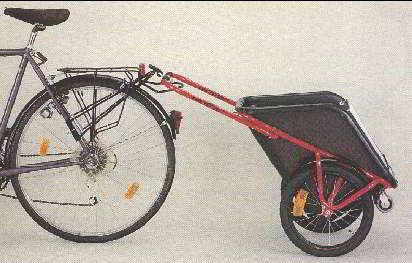
I've tried a few bike trailers in my time. Every time I see a new model I rush up to it curiously; I've bought (and returned) trailers, and I've taken a hacksaw to trailers. Sometimes I've even taken a pencil and tried to design my own...
This year (Spring 2000) I finally found the most practical, workable trailer yet. Except for not folding :-) it is ideal in every way. It's called the Winthers Donkey, and it comes from Denmark. I seem to be the only person in California who owns one, but Stein Somers in London has a Donkey Page so there is at least one in the UK!
Further below I offer the tale of how I managed to buy a trailer from Denmark, in case you are inspired to do likewise. But let's talk about the trailer first.
The trailer arrived adequately packaged. The carton had suffered a little in transit but the contents were fine. Assembly was minimal, but the instructions are not in English -- in fact, there's no text to speak of, just pictures. I had to put the handle together, and attach the wheels (three of them, two spoked side wheels and a mid-size castor wheel in back). It was rather blazingly obvious which piece went where, hardly rocket science.
This is the official Winthers picture of the Donkey.

The wheel bearings were misadjusted when they arrived -- one was far too tight and was binding, the other too loose. It was trivial to adjust them, and Winthers gave me very clear and helpful instructions via email on this matter.
The trailer frame is steel tubing, heavily enamelled in your choice of gloss black or gloss red. I chose black. The official photo shows the red frame. The welds look good and the paint is excellent.
The trailer comes with a rain cover. This is a plasticized nylon cloth cover, elastic all the way around, which stretches onto the trailer like a hairnet gripping the curled rim of the cargo basket. The default cover colour is screaming red -- at least that is what I got.
With the trailer you also get a hitch (as seen in the Winthers photo above) which in isolation looks like this:
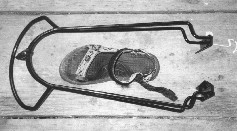
Here are some pics of the trailer so you can get a feel for its size and usefulness. Each photo is followed by some comments.
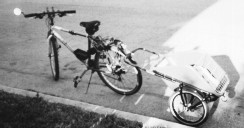
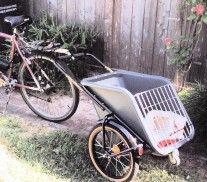
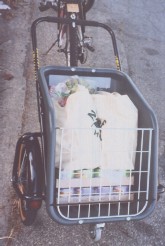
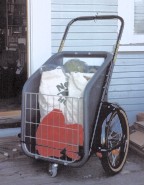
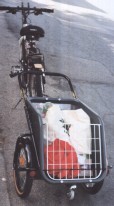
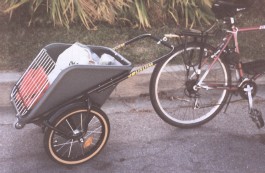
Despite the tilted-forward riding angle, you can carry fairly long things in the bed. I find the angle is just sufficient that long lumber projects upwards past my back when I am pedalling, with no contact. See my hardware store load and how it was secured.
It's really very simple. I ride up to the bike rack, lock the bike, detach the trailer, and wheel it into the store, using it as my shopping cart. It fits through any aisle that is wheelchair accessible (and this may be a bit of an eye-opener with some of your local stores; I have found that a few of mine are definitely wheelchair-hostile!). I flip the gate over to make a shelf and put the store shopping basket on that (Safeway baskets fit well, but the larger health food store baskets stick out and I have to put the heavy stuff on the inside). Or I just throw the purchases into the trailer and sort it all out at the counter.
The trailer wheels very well. The handle height is adjustable (with tools) so you can set it up for the height of the primary user. It turns on its own centre easily, due to the 3rd castor wheel, and it is quick and quite silent on most surfaces. People in the stores stare at it curiously as I go up and down the aisles, but they really look confused when they see my departure.
I wheel my groceries out of the store, unlock the bike, hitch the trailer to the bike in one move (tip down and snap the shackle), and ride away. This all takes a few seconds, while car-based shoppers are still lifting grocery bags from their noisy supermarket cart into their trunk or back seat... I'm on my way instantly, with no moral dilemma about leaving the supermarket cart or returning it to the corral!
Pulling a loaded trailer full of eggs, strawberries and other fragile items, obviously one slows down a little over the lumps and bumps. But the trailer tows well at normal cycling speed and except for "sparing the veggies" I do not feel hampered by its presence behind me. The wheel bearings are excellent (once adjusted properly I found the trailer wheels will spin for over 1 minute, as good as my bike wheels).
As noted above, when I get home I ride right into the front yard, put the bike on its kickstand, unhitch, and pull the trailer up three steps, over the door sill, and wheel it right into the kitchen to unpack.
I am very pleased and satisfied with this trailer. At last I seem to have found a bike trailer that is not designed for heavy hauling in flat country, or for camping or carrying twins, but simply and conveniently for running errands and shopping. Being car-free, this is what I use my bike for all the time. Being able to take the trailer into stores with me obviates the nuisance of carrying extra locks and cables to secure it; not having to bungie everything down (as on a flatbed) or lift everything out and hand-carry it into the house are real advantages.
I recommend the Winthers Donkey highly for anyone who has to carry moderate-sized freight for long or short distances by bike. This is a sturdy, well-engineered and practical product, obviously designed and marketed in a culture where bikes and cycling are taken seriously. I quote the "trailers" text at www.fahrradstudio.at:
Ein Fahrradanhänger ist für fast jedes im Alltag genutzte Fahrrad eine wertvolle Ergänzung. Schließlich haben die meisten von uns hin und wieder etwas größere oder schwerere Lasten zu transportieren. Wozu gleich ein Auto verwenden oder gar kaufen? In vielen Fällen gehts mit einem Fahrrad-Anhänger genauso gut, und Sie tun dabei etwas für Ihre Gesundheit und für die Ihres Lebensraumes.I couldn't have put it better myself :-)A bike trailer is a worthwhile upgrade for almost every bike that sees daily use. In the end, most of us have to transport something big or heavy. Why rent or buy a car? In many cases you can do just as well with a bike trailer, and at the same time improve your own health and your environment.
How I Bought a Donkey Sight Unseen
I first saw it on the website
of an Austrian bike shop.
I was surfing around looking at bike trailers, and this site just
happened to pop up (check out the pretty Vitelli Camping, btw!).
I saw the Donkey picture and said, "Hey, that looks almost ideal!"
Having a little rusty German still, I wrote to them to ask if
the Donkey were available in the US. No, they said, they couldn't sell
internationally, but check with the manufacturer, Winthers AS.
I sent email to Winthers and was delighted and relieved to discover the excellent written English of their representative Ms Vibeke Juhl. I have not one word of Danish, and had thought we might have to do business in French or German, but no -- Ms Juhl writes near-native English, besides being friendly, helpful, and responsive. (You can reach Ms Juhl at win@a-winther.dk)
We quickly established that Winthers does not take credit cards, but accepts international wire transfers. The cost of the trailer (shipping included) was bout 1570 Danish kroene, or about 200 US dollars. It cost me an additional $18 or so for the wire transfer. Note that a Bykaboose Gecko costs about the same (I returned the one I bought) and a Burley costs a bit more.
Incidentally amusing story: I faxed my bank instructions to wire 1570 DKK to Winther via the appropriate New York bank; a couple of days later there was a plaintive message on my answering machine from a clerk at the bank: "We need to know the amount in US dollars." I found this odd, since they have Web access and could have instantly consulted the same currency exchange page I used to answer their question... I called them up and read them the exchange rate, but even that was not good enough: apparently bank clerks no longer know how to multiply, 'cos I had to do the math for them too. And they call the US a service economy?But never mind, after only a slight delay due to my bank's helplessness in the face of non-US currency, the money was transferred. Should you wish to do this yourself, I've included here a sample fax based on the one I sent to my bank. You could copy this and edit it suitably for your own use.
Winthers responded instantly with a UPS international tracking number, so I had no difficulty tracking my package as it bounced around the EU and the US. From my desk I could find out each day, "My Donkey is in Germany, my Donkey is in New York!" and so forth, until it was delivered, to the hour as predicted, on my doorstep in Santa Cruz CA. I had thought there might be customs or import duties, but I have heard nothing from UPS or the US Customs about it, so apparently there were none. Transit time was one week Denmark-to-California, which I thought was darned good. I've had packages within the US take longer!
Please note: I am not related to anyone who works for Winthers, I am not getting any kickback from Winthers. I am just so tickled about this excellent trailer that I have to share the info with other cyclists. If Winthers suddenly gets lots of Donkey orders from the US, maybe they will send me one of the really nifty rain covers with black and white checks :-) (nudge nudge, wink wink). But seriously, this is not advertising. This is my real opinion.

The hitch supplied by Winthers is similar to the BoB trailer "bustle" hitch, intended to be attached permanently to the bike. It has strong anti-roll features and a quick-disconnect spring clip.
I took one look at this monster, hefted it, and said, "Not on my bike
you don't." Since the Donkey's hitch is absurdly simple -- just a
large stainless eye bolt through the centre of the handle -- I started
improvising a hitch out of whatever was lying around. This was
the first draft 
which was the bike's reflector mount, rapidly modified. I know
the photo is a little small and obscure, but try to visualize this:
the topmost bolt goes
through the bike rack, so the open end of the taped tang is
pointing almost straight up when it's mounted. The eyebolt on
the Donkey slips over the tang. The rubber band is then stretched
across the whole assembly to keep the eye bolt from leaping off the tang.
This was clearly not very nice, and it lasted only one anxious try-out trip to the store. I quickly lashed up hitch number 2

This hitch almost worked for a while, but the aluminium stock was not strong enough. Coming home with a trailer full of groceries, I applied the brakes when running down a slight grade and the trailer snuggled up and bent the hitch down against the rear tyre! This was hardly a disaster, but some of the rubber handgrip was abraded off the Donkey handle.
Hitch number 3


The wood didn't hold up well, as I expected, and started to crack after just a couple of trips. But by then I was happy with the geometry and had visited the scrap bin at a friendly machine shop, coming away with a nice hunk of heavy aluminium. A quick visit to a friend with a drill press, and presto! Hitch number 4 was born.
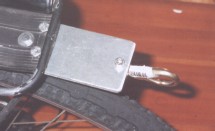

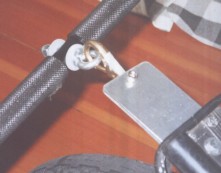
Important note Hitch number 2 had an upwards-opening spring clip. I thought it would be nice to drop the eyebolt into it from above. Wrong. The angle of the trailer handle and eye bolt is not right, so the hitch has to bend down at about 45 degrees for this to work. Hitch number 3, aside from being based on a fragile piece of wood, had a swivel spring clip, the idea being that it could latch on sideways (eye bolt rotated to vertical position) and then swivel freely. Wrong. The free swivelling was a nightmare -- the eyebolt and clip would rotate themselves into annoying wedged configurations (like those old-fashioned puzzles made from bent nails) which were difficult to undo. Hitch number 4 finally gets it right and has the shackle spring gate opening downwards, and I advise you do likewise. It takes about 1/2 second to attach and detach the trailer.
Winthers is rather alarmed that I'm not using their massive bustle hitch. They say it's needed to suppress the natural tendency of two-wheeled trailers to tip. I have towed the Donkey over potholes, up driveways, over railroad tracks, and even over those car-stopping concrete bars one finds in parking lots (oops). I have never had the slightest tippage. The Donkey always lands on its feet.
[UPDATE a few weeks later: I have now tipped over the Donkey. Here's the story but it comes with some large pics, so it's slow to load, sorry. I'll try to shrink them down soon. This experience reinforces my advice below -- don't carry a kid in the Donkey using a light hitch like mine. For human cargo, use the official hitch. The trailer will survive the impact, but the kid might not, so play it safe.]
Now, I do load it carefully with the heavy stuff on the bottom, and I never plan to carry a small child on the gate/seat. So I think my CoG is low enough that tipping is unlikely. YMMV!
If you do plan to carry a toddler on the seat, I would strongly recommend using the Winthers hitch! The towed kid will raise the CoG well above axle level and the whole assembly will be far less stable. Do not abandon the Winthers hitch unless you never plan to carry a child in the trailer.